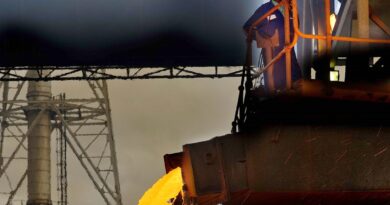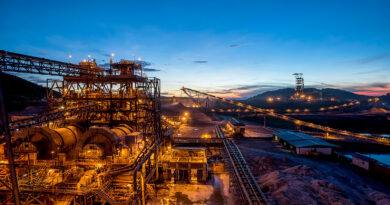Sibanye Stillwater SA PGM operations produced solid performance
The SA PGM operations produced another solid operational performance for Q3 2023, with leading cost management again standing out as a key differentiator in the SA PGM industry. Production of 451,560 4Eoz (excluding third party purchase of concentrate (PoC)) for Q3
2023 was 4% higher than for Q3 2022, due to improved production from the Rustenburg and Marikana operations, which offset lower production from the Kroondal operation as a consequence of the planned closure of the Simunye shaft during 2022.
Production (including PoC) was 6% higher year-on-year at 475,555 4Eoz due to third party PoC processing increasing by 44% to 23,995 4Eoz year-on-year.
In contrast to Q3 2022, which was impacted by the beginning of elevated levels of power curtailment imposed by Eskom, no ore stockpiles were reported at the end of Q3 2023 compared with the end of Q3 2022 when underground ore containing approximately
33,000 4Eoz was stockpiled on surface. The Group’s strategic response to the load curtailment has been very effective, underpinned by the relative advantage of processing capacity that averts the risk of accumulating “deferred production”.
AISC (excluding third-party PoC) for Q3 2023 of R20,080/4Eoz (US$1,080/4Eoz) was just 5% higher than for Q3 2022, below prevailing South African consumer price inflation (CPI) and reflecting ongoing industry-leading cost management. AISC (including PoC) was R20,029/4Eoz (US$1,077/4Eoz) 1% lower year-on-year reflecting the significant decline in PGM prices year-on-year despite the 44% increase in PoC purchases to 23,995 4Eoz . The well contained AISC benefited from a 16% year-on-year increase in by-product credits driven largely by higher chrome prices, and lower royalties which offset ORD and sustaining capital increases of 5% and 4% respectively. A 78% decrease in royalty costs year-on-year was also notable with by-product credits of R2.5bn (US$133 million) for the period exceeding the combined value of royalties, inventory change, ORD and sustaining capital. AISC (including PoC) was also lower with third party PoC cost 28% lower at R565 million (US$30 million) despite an increase in PoC volumes, which were offset by lower PGM prices.
Despite this solid performance, four shafts have become unprofitable following the precipitous decline in the 4E PGM basket price, necessitating restructuring for profitability and sustainability in the longer term (see announcement below of SA PGM Section 189).
Capital expenditure of R1,440 million (US$77 million) for Q3 2023 was 14% higher than for Q3 2022 with ORD 5% higher at R622 million (US$33 million), sustaining capital 4% higher at R484 million (US$26 million) and project capital 61% higher at R334 million (US$18 million) as a result of the 30% increase year-on-year in the project capital (R270 million (US$15 million)) at the K4 project at the Marikana operation and R64 million (US$3 million) spent on the new chrome extraction plant at Platinum Mile during Q3 2023, which is due to be commissioned in Q4 2023.
4E PGM production from the Rustenburg operation for Q3 2023 of 182,022 4Eoz was 1% higher year-on-year with underground production 2% higher and surface production 2% lower. The improvement in underground production was achieved despite difficult ground
conditions impacting productivity at the Thembelani shaft and seismic activity during 2022 at the Siphumelele shaft (restricting access to planned production areas). Mining through the Hexriver fault, which has impacted productivity from the Bathopele shaft, has largely been traversed and production is steadily improving. AISC from the Rustenburg operation was again very well contained, increasing by only 1% to R18,701/4Eoz (US$1,006/4Eoz) year-on-year. A 13% increase in by-product credits driven mainly by the chrome price which increased by 28% year-on-year and a 73% decline in royalties offset inflationary cost pressures and a 23% decline in ORD capital.
By-product credits from the Rustenburg operation were negatively impacted by port constraints, which restricted chrome sales. The Rustenburg operations continue to move down the cost curve as a result of good cost management and with ground conditions improving, the outlook for sustained production is positive.
4E PGM production for Q3 2023 from the Marikana operation (excluding third party PoC) of 179,014 4Eoz, was 9% higher than for Q3 2022, with underground production and surface production 9% and 12% higher respectively due to lower impact from load curtailment and
cable theft than Q3 2022. 4E PGM production (including PoC) of 203,009 4Eoz for Q3 2023 was 13% higher than for Q3 2022 with PoC increasing by 44% year-on-year to 23,995 4Eoz due to higher contractual deliveries from third parties. AISC (excluding third party PoC) for
Q3 2023 of R22,607/4Eoz (US$1,216/4Eoz) increased by only 4%, primarily due to higher production, which largely offset an increase in ORD of 19% to R473 million(US$25 million) and a 14% increase in sustaining capital to R276 million (US$15 million). The year-on-year increase in ORD and sustaining capital at Marikana is primarily due to the ramp-up of the K4 shaft. Since K4 commenced stoping and development operations outside the main shaft infrastructure in March 2023, on reef development was expensed in working costs with off reef development capitalised as ORD. While the K4 project remains in build-up phase, unit operating costs, ORD and sustaining capital remain temporarily elevated, but are expected to reduce as production builds up, benefiting costs from the Marikana operation. AISC (including PoC) for Q3 2023 at Marikana declined by 6% compared with Q3 2022 to R22,196/4Eoz (US$1,194/4Eoz).
Other factors resulting in lowering the AISC were a 33% increase in by-product credits, royalties which were 89% lower due to lower commodity prices and the cost of PoC from third parties, which was 28% lower than for Q3 2022 at R565 million (US$30 million) due to the lower basket price, despite higher PoC volumes.
4E PGM production from the Kroondal operation of 47,600 4Eoz for Q3 2023 was 1% lower than for the comparable period in 2022 due to the Simunye shaft reaching the end of its life and winding down main production activities (ceasing during Q4 2022) and reduced productivity and increased dilution from the Bambanani shaft which is mining through a shear zone.
AISC of R18,550/4Eoz (US$998/4Eoz) was 20% higher than for Q3 2022 primarily due to lower production, higher inflationary costs as highlighted above as well as higher support costs, due to the mining through adverse ground conditions at the shear zone.
By-product credits were also 37% lower due to lower chrome production associated with the termination of primary mining at the Simunye shaft and reduced offtake from a contracted party. Chrome production is expected to increase in future.
Attributable 4E PGM production from Mimosa of 29,060 4Eoz was 1% higher than Q3 2022. AISC increased by 10% year-on-year to US$1,359/4Eoz (R25,258/4Eoz) due to inflationary pressures being experienced in Zimbabwe, in particular electricity costs which rose for exporters by 40% in October 2022, the first increase since 2014. Sustaining capital remained elevated at US$14 million (R266 million) primarily associated with the ongoing construction of the new tailings storage facility (TSF) which is due to be commissioned between December 2023 and March 2024.
PGM production from Platinum Mile in Q3 2023 of 13,864 4Eoz was 13% higher year-on-year due to a 14% increase in yield as a result of higher grade coupled with improved recoveries. AISC at Platinum Mile declined by 5% year-on-year to R10,747/4Eoz (US$578/4Eoz), primarily as a result of higher 4E PGM production. Project capital spend of R64 million (US$3 million) in Q3 2023 was incurred on expenditure on the chrome extraction plant which is expected to be commissioned in December 2023 with total capital spend forecast at R130 million (US$7 million). This plant is planned to produce around 240,000 tonnes of chrome per year.
Chrome sales from the SA PGM operations for Q3 2023 of approximately 554kt were 1% lower than Q3 2022. The chrome price received increased by 28% year-on-year to US$290/tonne (Q3 2022: US$227/tonne), underpinning a 25% increase in chrome revenue to R1.0 billion (US$56 million).




